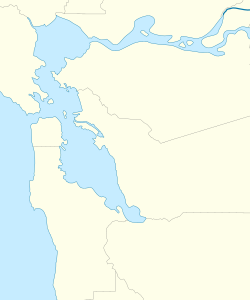Berkeley, California
Berkeley | |
|---|---|
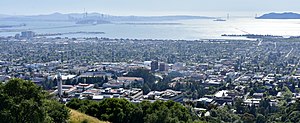 Looking west over the city from the Berkeley Hills, with San Francisco in the background | |
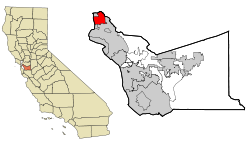 Location of Berkeley in Alameda County, California | |
| Coordinates: 37°52′18″N 122°16′22″W / 37.87167°N 122.27278°W | |
| Country | United States |
| State | California |
| County | Alameda |
| Incorporated | April 4, 1878[1] |
| Chartered | March 5, 1895[2] |
| Named for | George Berkeley |
| Government | |
| • Type | Council-Manager[2] |
| • Mayor | Jesse Arreguín[3] |
| • Council members by district number[3] |
|
| • FIPS code | 06-06000 |
| GNIS feature IDs | 1658037, 2409837 |
| Website | berkeleyca |
Berkeley (
Berkeley is home to the oldest campus in the University of California, the University of California, Berkeley, and the Lawrence Berkeley National Laboratory, which is managed and operated by the university. It also has the Graduate Theological Union, one of the largest religious studies institutions in the world. Berkeley is considered one of the most socially progressive cities in the United States.
History
Indigenous history

The site of today's City of Berkeley was the territory of the Chochenyo/Huchiun
Spanish and Mexican eras
The first people of European descent (most of whom were of mixed race and born in America
Luis Peralta named his holding "
The Peraltas' Rancho San Antonio continued after
Politically, the area that became Berkeley was initially part of a vast
Late 19th century

In 1866, Oakland's private College of California looked for a new site. It settled on a location north of Oakland along the foot of the Contra Costa Range (later called the Berkeley Hills) on Strawberry Creek, at an elevation of about 500 feet (150 m) above the bay, commanding a view of the Bay Area and the Pacific Ocean through the Golden Gate.
According to the Centennial Record of the University of California, "In 1866, at
The College of California's College Homestead Association planned to raise funds for the new campus by selling off adjacent parcels of land. To this end, they laid out a plat and street grid that became the basis of Berkeley's modern street plan. Their plans fell far short of their desires, and they began a collaboration with the State of California that culminated in 1868 with the creation of the public University of California.


As construction began on the new site, more residences were constructed in the vicinity of the new campus. At the same time, a settlement of residences, saloons, and various industries grew around the wharf area called
By the 1870s, the
There was a strong prohibition movement in Berkeley at this time. In 1876, the state enacted the "mile limit law", which forbade sale or public consumption of alcohol within one mile (1.6 km) of the new University of California.[18] Then, in 1899, Berkeley residents voted to make their city an alcohol-free zone. Scientists, scholars and religious leaders spoke vehemently of the dangers of alcohol.[19]
On April 1, 1878, the people of Ocean View and the area around the university campus, together with local farmers, were granted
Due to the influence of the university, the modern age came quickly to Berkeley.
Early 20th century

Berkeley's slow growth ended abruptly with the
In 1904, the first hospitals in Berkeley were created: the Alta Bates Sanatorium (today Alta Bates Summit Medical Center) for women and children, founded by nurse
In 1908, a statewide referendum that proposed moving the California state capital to Berkeley was defeated by a margin of about 33,000 votes.[26] The city had named streets around the proposed capitol grounds for California counties. They bear those names today, a legacy of the failed referendum.
On March 4, 1909, following public referendums, the citizens of Berkeley were granted a new charter by the State of California, and the Town of Berkeley became the City of Berkeley.[27] Rapid growth continued up to the Crash of 1929. The Great Depression hit Berkeley hard, but not as hard as many other places in the U.S., thanks in part to the university.
In 1916, Berkeley implemented single-family zoning as an effort to keep minorities out of white neighborhoods. This has been described as the first implementation of single-family zoning in the United States[28][29][30] By 2021, nearly half of Berkeley's residential neighborhoods were still exclusively zoned for single-family homes.[31]
On September 17, 1923,
The next big growth occurred with the advent of World War II, when large numbers of people moved to the Bay Area to work in the many war industries, such as the immense Kaiser Shipyards in nearby Richmond. One who moved out, but played a big role in the outcome of the war, was U.C. professor and Berkeley resident J. Robert Oppenheimer. During the war, an Army base, Camp Ashby, was temporarily sited in Berkeley.
The element berkelium was synthesized utilizing the 60-inch (1.5 m) cyclotron at UC Berkeley, and named in 1949, in recognition of the university, thus placing the city's name in the list of elements.
1940–60s
During the 1940s, many African Americans migrated to Berkeley.[32] In 1950, the Census Bureau reported Berkeley's population as 11.7% black and 84.6% white.[33]
The postwar years brought moderate growth to the city, as events on the U.C. campus began to build up to the recognizable activism of the sixties. In the 1950s,

Berkeley is strongly identified with the rapid social changes, civic unrest, and political upheaval that characterized the late 1960s.
The battle over the disposition of People's Park resulted in a month-long occupation of Berkeley by the
The era of large public protest in Berkeley waned considerably with the end of the Vietnam War in 1975. While the 1960s were the heyday of liberal activism in Berkeley, it remains one of the most overwhelmingly Democratic cities in the United States.
1970s and 1980s
Housing and zoning changes
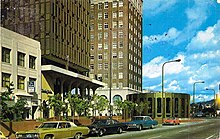
After the 1960s, Berkeley banned most new housing construction, in particular apartments.[35]
Increasing enrollment at the university led to replacement of older buildings by large apartment buildings, especially in older parts of the city near the university and downtown. Increasing enrollment also led the university to wanting to redevelop certain places of Berkeley, especially Southside, but more specifically People's Park.
Political movements
During the 1970s and 1980s, activists increased their power in local government. This era also saw major developments in Berkeley's environmental and food culture. Berkeley's last Republican mayor, Wallace J. S. Johnson, left office in 1971. Alice Waters opened Chez Panisse in 1971. The first curbside recycling program in the U.S. was started by the Ecology Center in 1973. Styrofoam was banned in 1988.[40]
As the city leaned more and more Democratic, local politics became divided between "Progressives" and "Moderates". 1984 saw the Progressives take the majority for the first time. Nancy Skinner became the first UC Berkeley student elected to City Council. In 1986, in reaction to the 1984 election, a ballot measure switched Berkeley from at-large to district-based elections for city council.[41]
In 1983, Berkeley's
1990s and 2000s

In 1995, California's Costa–Hawkins Act ended vacancy control, allowing rents to increase when a tenant moved out. Despite a slow down in 2005–2007, median home prices and rents remain dramatically higher than the rest of the nation,[43] fueled by spillover from the San Francisco housing shortage and population growth.
South and West Berkeley underwent gentrification, with some historically Black neighborhoods such as the Adeline Corridor seeing a 50% decline in Black / African American population from 1990 to 2010.[44] In the 1990s, public television's Frontline documentary series featured race relations at Berkeley's only public high school, Berkeley High School.[45]
With an economy dominated by the University of California and a high-demand housing market, Berkeley was relatively unaffected by the Great Recession. State budget cuts caused the university to increase the number of out-of-state and international students, with international enrollment, mostly from Asia, rising from 2,785 in 2007 to 5,951 in 2016.[46] Since then, more international restaurants have opened downtown and on Telegraph Avenue, including East Asian chains such as Ippudo and Daiso.
A wave of downtown apartment construction began in 1998.[47]
In 2006, the
In 2007–2008, Berkeley received media attention due to demonstrations against a Marine Corps recruiting office in downtown Berkeley and a series of controversial motions by Berkeley's city council regarding opposition to Marine recruiting. (See
2010s and 2020s
During the fall of 2010, the
On September 18, 2012, Berkeley became what may be the first city in the U.S. to officially proclaim a day recognizing bisexuals: September 23, which is known as Celebrate Bisexuality Day.[48]
On September 2, 2014, the city council approved a measure to provide free
The Measure D
Protests
In the fall of 2011, the nationwide Occupy Wall Street movement came to two Berkeley locations: on the campus of the University of California and as an encampment in Civic Center Park.
During a Black Lives Matter protest on December 6, 2014, police use of tear gas and batons to clear protesters from Telegraph Avenue led to a riot and five consecutive days and nights of protests, marches, and freeway occupations in Berkeley and Oakland.[51] Afterwards, changes were implemented by the Police Department to avoid escalation of violence and to protect bystanders during protests.[52]
During a protest against bigotry and U.S. President Donald Trump in August 2017, anti-fascist protesters grew violent against Trump supporters in attendance. Police intervened, arresting 14 people. Sometimes called "antifa", these anti-fascist activists were clad in all black, while some carried shields and others had masks or bandanas hiding their faces.[53] These protests spanned February to September 2017 (See more at 2017 Berkeley Protests).[54]
In 2019, protesters took up residence in People's Park against tree-chopping and were arrested by police in riot gear. Many activists saw this as the university preparing to develop the park.[55]
Homelessness
The city of Berkeley has historically been a central location for homeless communities in the Bay Area.[56] Since the 1930s, the city of Berkeley has fostered a tradition of political activism.[57] The city has been perceived as a hub for liberal thought and action and it has passed ordinances to oust homeless individuals from Berkeley on multiple occasions.[58] Despite efforts to remove unhoused individuals from the streets and projects to improve social service provision for this demographic, homelessness has continued to be a significant problem in Berkeley.[59]
1960s
A culture of anti-establishment and sociopolitical activism marked the 1960s.[57] The San Francisco Bay Area became a hotspot for hippie counterculture, and Berkeley became a haven for nonconformists and anarchists[57] from all over the United States.[60] Most public discourse around homelessness in Berkeley at this time was centered around the idea of street-living as an expression of counterculture.[56]
During the Free Speech Movement in the fall of 1964, Berkeley became a hub of civil unrest, with demonstrators and UC Berkeley students sympathizing with the statewide protests for free speech and assembly, as well as revolting against university restrictions against student political activities and organizations established by UC President Clark Kerr in 1959. Many non-student youth and adolescents sought alternative lifestyles and opted for voluntary homelessness during this time.[61][62]
In 1969, People's Park was created and eventually became a haven for "small-time drug dealers, street people, and the homeless".[63] Although the City of Berkeley has moved unhoused individuals from its streets, sometimes even relocating them to an unused landfill, People's Park has remained a safe space for them since its inception.[63] The park has become one of the few relatively safe spaces for homeless individuals to congregate in Berkeley and the greater Bay Area.[63]
1970s
Stereotypes of homeless people as deviant individuals who chose to live vagrant lifestyles continued to color the discourse around street-dwellers in American cities.[56] However, this time period was also characterized by a subtle shift in the perception of unhoused individuals. The public began to realize that homelessness affected not only single men, but also women, children, and entire families.[56] This recognition set the stage for the City of Berkeley's attitude towards homelessness in the next decade.[64]
1980s
Organizations such as Building Opportunities for Self Sufficiency (BOSS) were established in 1971 in response to the needs of individuals with mental illness being released to the streets by state hospital closures.[65]
1990s
In the 1990s, the City of Berkeley faced a substantial increase in the need for emergency housing shelters and saw a rise in the average amount of time individuals spent without stable housing.[58] As housing became a more widespread problem, the general public, Berkeley City Council, and the University of California became increasingly anti-homeless in their opinions.[58] In 1994, Berkeley City Council considered the implementation of a set of anti-homeless laws that the San Francisco Chronicle described as being "among the strictest in the country".[56] These laws prohibited sitting, sleeping and begging in public spaces, and outlawed panhandling from people in a variety of contexts, such as sitting on public benches, buying a newspaper from a rack, or waiting in line for a movie.[56] In February 1995, the American Civil Liberties Union (ACLU) sued the city for infringing free speech rights through its proposed anti-panhandling law.[56] In May of that same year, a federal judge ruled that the anti-panhandling law did violate the First Amendment, but left the anti-sitting and sleeping laws untouched.[56]
Following the implementation of these anti-sitting and sleeping ordinances in 1998, Berkeley increased its policing of homeless adults and youth, particularly in the shopping district surrounding Telegraph Avenue.[66] The mayor at that time, Shirley Dean, proposed a plan to increase both social support services for homeless youth and enforcement of anti-encampment laws.[66] Unhoused youth countered this plan with a request for the establishment of the city's first youth shelter, more trash cans, and more frequent cleaning of public bathrooms.[66]
21st century
The City of Berkeley's 2017 annual homeless report and point-in-time count (PIT) estimate that on a given night, 972 people are homeless.[67] Sixty-eight percent (664 people) of these individuals are also unsheltered, living in places not considered suitable for human habitation, such as cars or streets.[67] Long-term homelessness in Berkeley is double the national average, with 27% of the city's homeless population facing chronic homelessness.[67] Chronic homelessness has been on the rise since 2015, and has been largely a consequence of the constrained local housing market.[67] In 2015, rent in Alameda County increased by 25%, while the average household income only grew by 5%.[68] The City of Berkeley's 2017 report also estimated the number of unaccompanied youth in Berkeley at 189 individuals, 19% of the total homeless population in the city. Homeless youth display greater risk of mental health issues, behavioral problems, and substance abuse, than any other homeless age group.[62] Furthermore, homeless youth identifying as LGBTQ+ are exposed to greater rates of physical and sexual abuse, and higher risk for sexually-transmitted diseases, predominantly HIV.[69][70]
The City of Berkeley has seen a consistent rise in the number of chronically homeless individuals over the past 30 years, and has implemented a number of different projects to reduce the number of people living on the streets.[71] In 2008, the City focused its efforts on addressing chronic homelessness. This led to a 48% decline in the number of chronically homeless individuals reported in the 2009 Berkeley PIT.[72] However, the number of "hidden homeless" individuals (those coping with housing insecurity by staying at a friend or relative's residence), increased significantly, likely in response to rising housing costs and costs of living.[72] In 2012, the City considered measures that banned sitting in commercial areas throughout Berkeley.[72] The measure was met with strong public opposition and did not pass. However, the City saw a strong need for it to implement rules addressing encampments and public usage of space as well as assessing the resources needed to assist the unhoused population.[72] In response to these needs the City of Berkeley established the Homeless Task Force, headed by then-Councilmember Jesse Arreguín.[72] Since its formation, the Task Force has proposed a number of different recommendations, from expanding the City Homeless Outreach and Mobile Crisis Teams, to building a short-term transitional shelter for unhoused individuals.[73]
Geography
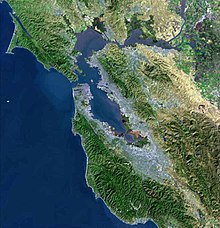
According to the United States Census Bureau, the city's 17.7-square-mile (46 km2) area includes 10.5 square miles (27 km2) of land and 7.2 square miles (19 km2) (40.83%) water, most of it part of San Francisco Bay.
Berkeley borders the cities of Albany, Oakland, and Emeryville and Contra Costa County, including unincorporated Kensington, as well as San Francisco Bay.
Berkeley lies within telephone
Geology
Most of Berkeley lies on a rolling sedimentary plain that rises gently from sea level to the base of the
The Berkeley Hills are part of the Pacific Coast Ranges, and run in a northwest–southeast alignment. Exposed in the Berkeley Hills are cherts and shales of the Claremont Formation (equivalent to the Monterey Formation), conglomerate and sandstone of the Orinda Formation and lava flows of the Moraga Volcanics. Of similar age to the Moraga Volcanics (extinct), within the Northbrae neighborhood of Berkeley, are outcroppings of erosion resistant rhyolite. These rhyolite formations can be seen in several city parks and in the yards of a number of private residences. Indian Rock Park in the northeastern part of Berkeley near the Arlington/Marin Circle features a large example.
Earthquakes
Berkeley is traversed by the Hayward Fault Zone, a major branch of the San Andreas Fault to the west. No large earthquake has occurred on the Hayward Fault near Berkeley in historic times (except possibly in 1836), but seismologists warn about the geologic record of large temblors several times in the deeper past. The current assessment is that a Bay Area earthquake of magnitude 6.7 or greater within the next 30 years is likely, with the Hayward Fault having the highest likelihood among faults in the Bay Area of being the epicenter.[75] Moreover, like much of the Bay Area, Berkeley has many areas of some risk to soil liquefaction, with the flat areas closer to the shore at low to high susceptibility.[76]
The
Today, evidence of the Hayward Fault's "creeping" is visible at various locations in Berkeley. Cracked roadways, sharp jogs in streams, and springs mark the fault's path. However, since it cuts across the base of the hills, the creep is often concealed by or confused with slide activity. Some of the slide activity itself, however, results from movement on the Hayward Fault.
A notorious segment of the Hayward Fault runs lengthwise down the middle of Memorial Stadium at the mouth of Strawberry Canyon on the University of California campus.[79] Photos and measurements show the movement of the fault through the stadium.[80]
Climate
Berkeley has a
Winter is punctuated with rainstorms of varying ferocity and duration, but also produces stretches of bright sunny days and clear cold nights. It does not normally snow, though occasionally the hilltops get a dusting. Spring and fall are transitional and intermediate, with some rainfall and variable temperature. Summer typically brings night and morning low clouds or fog, followed by sunny, warm days. The warmest and driest months are typically June through September, with the highest temperatures occurring in September. Mid-summer (July–August) is often a bit cooler due to the sea breezes and fog common then.
In a year, there are an average of 2.9 days with highs of 90 °F (32 °C) or higher, and an average of 0.8 days with lows of 32 °F (0 °C) or lower. The highest recorded temperature was 107 °F (42 °C) on June 15, 2000, and July 16, 1993, and the lowest recorded temperature was 24 °F (−4 °C) on December 22, 1990.
February is normally the wettest month, averaging 5.21 inches (132 mm) of precipitation. Average annual precipitation is 25.40 inches (645 mm), falling on an average of 63.7 days each year. The most rainfall in one month was 14.49 inches (368 mm) in February 1998. The most rainfall in 24 hours was 6.98 inches (177 mm) on January 4, 1982.
In the late spring and early fall, strong
| Climate data for Berkeley, California (1991–2020 normals, extremes 1893–present) | |||||||||||||
|---|---|---|---|---|---|---|---|---|---|---|---|---|---|
| Month | Jan | Feb | Mar | Apr | May | Jun | Jul | Aug | Sep | Oct | Nov | Dec | Year |
| Record high °F (°C) | 78 (26) |
81 (27) |
87 (31) |
95 (35) |
101 (38) |
107 (42) |
99 (37) |
104 (40) |
106 (41) |
99 (37) |
86 (30) |
78 (26) |
107 (42) |
| Mean maximum °F (°C) | 66.7 (19.3) |
72.1 (22.3) |
77.1 (25.1) |
82.0 (27.8) |
86.0 (30.0) |
90.9 (32.7) |
87.1 (30.6) |
89.0 (31.7) |
91.7 (33.2) |
87.6 (30.9) |
76.4 (24.7) |
66.5 (19.2) |
95.6 (35.3) |
| Mean daily maximum °F (°C) | 58.9 (14.9) |
61.6 (16.4) |
64.6 (18.1) |
67.3 (19.6) |
70.0 (21.1) |
74.1 (23.4) |
74.2 (23.4) |
74.7 (23.7) |
76.3 (24.6) |
73.4 (23.0) |
65.2 (18.4) |
58.6 (14.8) |
68.2 (20.1) |
| Daily mean °F (°C) | 51.1 (10.6) |
53.0 (11.7) |
55.2 (12.9) |
57.0 (13.9) |
59.7 (15.4) |
62.9 (17.2) |
63.7 (17.6) |
64.4 (18.0) |
64.9 (18.3) |
62.5 (16.9) |
56.1 (13.4) |
50.9 (10.5) |
58.5 (14.7) |
| Mean daily minimum °F (°C) | 43.3 (6.3) |
44.5 (6.9) |
45.9 (7.7) |
46.7 (8.2) |
49.4 (9.7) |
51.7 (10.9) |
53.2 (11.8) |
54.2 (12.3) |
53.6 (12.0) |
51.6 (10.9) |
46.9 (8.3) |
43.2 (6.2) |
48.7 (9.3) |
| Mean minimum °F (°C) | 36.2 (2.3) |
37.0 (2.8) |
38.8 (3.8) |
40.4 (4.7) |
44.9 (7.2) |
47.7 (8.7) |
50.1 (10.1) |
51.2 (10.7) |
49.4 (9.7) |
45.8 (7.7) |
40.0 (4.4) |
35.6 (2.0) |
33.4 (0.8) |
| Record low °F (°C) | 25 (−4) |
29 (−2) |
33 (1) |
28 (−2) |
36 (2) |
40 (4) |
40 (4) |
46 (8) |
38 (3) |
39 (4) |
33 (1) |
24 (−4) |
24 (−4) |
| Average precipitation inches (mm) | 4.84 (123) |
5.12 (130) |
3.84 (98) |
1.83 (46) |
0.80 (20) |
0.26 (6.6) |
0.01 (0.25) |
0.05 (1.3) |
0.12 (3.0) |
1.19 (30) |
2.74 (70) |
5.32 (135) |
26.12 (663) |
| Average precipitation days (≥ 0.01 in) | 11.3 | 10.5 | 9.8 | 7.0 | 3.4 | 1.2 | 0.3 | 0.6 | 1.0 | 3.2 | 7.3 | 11.0 | 66.6 |
| Source: NOAA[84][85] | |||||||||||||
Demographics
| Census | Pop. | Note | %± |
|---|---|---|---|
| 1890 | 5,101 | — | |
| 1900 | 13,214 | 159.0% | |
| 1910 | 40,434 | 206.0% | |
| 1920 | 56,036 | 38.6% | |
| 1930 | 82,109 | 46.5% | |
| 1940 | 85,547 | 4.2% | |
| 1950 | 113,805 | 33.0% | |
| 1960 | 111,268 | −2.2% | |
| 1970 | 114,091 | 2.5% | |
| 1980 | 103,328 | −9.4% | |
| 1990 | 102,724 | −0.6% | |
| 2000 | 102,743 | 0.0% | |
| 2010 | 112,580 | 9.6% | |
| 2020 | 124,321 | 10.4% | |
| U.S. Decennial Census[86] | |||
2020 census
| Race / Ethnicity (NH = Non-Hispanic) | Pop 2000[87] | Pop 2010[88] | Pop 2020[89] | % 2000 | % 2010 | % 2020 |
|---|---|---|---|---|---|---|
White (NH)
|
56,691 | 61,539 | 62,450 | 55.18% | 54.66% | 50.23% |
Black or African American (NH)
|
13,707 | 10,896 | 9,495 | 13.34% | 9.68% | 7.64% |
Alaska Native (NH)
|
293 | 228 | 226 | 0.29% | 0.20% | 0.18% |
| Asian (NH) | 16,740 | 21,499 | 24,701 | 16.29% | 19.10% | 19.87% |
| Pacific Islander (NH) | 121 | 170 | 253 | 0.12% | 0.15% | 0.20% |
| Some Other Race (NH) | 598 | 503 | 1,109 | 0.58% | 0.45% | 0.89% |
| Mixed race or Multiracial (NH) | 4,592 | 5,536 | 9,069 | 4.47% | 4.92% | 7.29% |
| Hispanic or Latino (any race) | 10,001 | 12,209 | 17,018 | 9.73% | 10.84% | 13.69% |
| Total | 102,743 | 112,580 | 124,321 | 100.00% | 100.00% | 100.00% |
The
Earlier census data

From the
The Census reported that 99,731 people (88.6% of the population) lived in households, 12,430 (11.0%) lived in non-institutionalized group quarters, and 419 (0.4%) were institutionalized.
There were 46,029 households, out of which 8,467 (18.4%) had children under the age of 18 living in them, 13,569 (29.5%) were

In the city, 13,872 people (12.3%) were under the age of 18, 30,295 people (26.9%) were aged 18 to 24, 30,231 people (26.9%) aged 25 to 44, 25,006 people (22.2%) aged 45 to 64, and 13,176 people (11.7%) were 65 years of age or older. The median age was 31.0 years. For every 100 females, there were 95.6 males. For every 100 females age 18 and over, there were 94.2 males.
According to the 2011 American Community Survey 5-Year estimate, the median income for a household in the city was $60,908, and the median income for a family was $102,976.[92] Males had a median income of $67,476 versus $57,319 for females. The per capita income for the city was $38,896. About 7.2% of families and 18.3% of the population were below the poverty line, including 13.2% of those under age 18 and 9.2% of those age 65 or over.
Berkeley has a higher-than-average crime rate, particularly property crime,[93] though the crime rate has fallen significantly since 2000.[94]
Transportation
Berkeley is served by
Berkeley has one of the highest rates of bicycle and pedestrian commuting in the nation. Berkeley is the safest city of its size in California for pedestrians and cyclists, considering the number of injuries per pedestrian and cyclist, rather than per capita.[95]

Berkeley has modified its original grid roadway structure through use of diverters and barriers, moving most traffic out of neighborhoods and onto arterial streets (visitors often find this confusing, because the diverters are not shown on all maps). Berkeley maintains a separate grid of arterial streets for bicycles, called
Berkeley hosts
. Rather than owning (and parking) their own cars, members share a group of cars parked nearby. Web- and telephone-based reservation systems keep track of hours and charges. Several "pods" (points of departure where cars are kept) exist throughout the city, in several downtown locations, at the Ashby and North Berkeley BART stations, and at various other locations in Berkeley (and other cities in the region). Using alternative transportation is encouraged.Berkeley has had recurring problems with parking meter vandalism. In 1999, over 2,400 Berkeley meters were jammed, smashed, or sawed apart.[97] Starting in 2005 and continuing into 2006, Berkeley began to phase out mechanical meters in favor of more centralized electronic meters.
Transportation history
The first commuter service to San Francisco was provided by the
The first electric rail service in Berkeley was provided by several small
The first electric commuter interurban-type trains to San Francisco from Berkeley were put in operation by the Key System in 1903, several years before the Southern Pacific electrified its steam commuter lines. Like the SP, Key trains ran to a pier serviced by the Key's own fleet of
After the Southern Pacific abandoned transbay service in 1941, the Key System acquired the rights to use its tracks and
Economy
Top employers
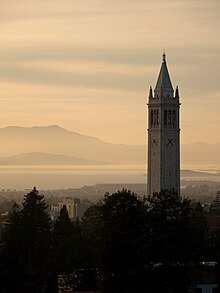
According to the city's 2021 Annual Comprehensive Financial Report,[102] the top employers in the city are:
| # | Employer | Employees |
|---|---|---|
| 1 | University of California, Berkeley | 13,669 |
| 2 | Lawrence Berkeley National Laboratory | 3,836 |
| 3 | Alta Bates Summit Medical Center (part of Sutter Health) | 2,040 |
| 4 | City of Berkeley | 1,480 |
| 5 | Bayer | 1,082 |
| 6 | Berkeley Unified School District | 865 |
| 7 | Kaiser Permanente | 771 |
| 8 | Siemens | 678 |
| 9 | Berkeley Bowl | 558 |
| 10 | Lifelong Medical Care | 441 |
Businesses
Berkeley is the location of a number of nationally prominent businesses, many of which have been pioneers in their areas of operation. Notable businesses include
Berkeley has relatively few
Places
Major streets
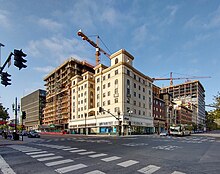
- downtown business district in Berkeley. It is named for Francis K. Shattuck, one of Berkeley's earliest influential citizens and the most prominent civic leader in the early history of Berkeley. He played an important role in the creation and government of Alameda County as well.
- University Avenue runs from Berkeley's bayshore and marina in the west to the University of California campus in the east.
- College Avenue, running from the University of California from the north to Broadway in Oaklandin the south close to the foothill, is a relatively quiet street compared with other major streets in Berkeley. It supports many restaurants and small shops.
- Ashby Avenue (Highway 13), which also runs from Berkeley's bayshore to the hills, connects with the Warren Freeway and Highway 24 leading to the Caldecott Tunnel, named for a former Berkeley mayor.
- San Pablo Avenue (Highway 123) runs north–south through West Berkeley, connecting Oakland and Emeryville to the south and Albanyto the north.
- Telegraph Avenue, which runs north–south from the university campus to Oakland, historically the site of much of the hippie culture of Berkeley.
- Martin Luther King Jr. Way, which until 1984 was called Grove Street, runs north–south a few blocks west of Shattuck Avenue, connecting Oakland and the freeways to the south with the neighborhoods and other communities to the north.
- Sacramento Street is one of the four streets with a median in Berkeley, running from Hopkins Street from the north to Alcatraz Ave in the south.
- Solano Avenue, a major street for shopping and restaurants, runs east–west near the north end of Berkeley, continuing into Albany. Since 1974, Solano Avenue has hosted the annual Solano Avenue Stroll and Parade[105] of the twin-cities of Albany and Berkeley, the East Bay's largest street festival.
Freeways
- The ) runs along Berkeley's bayshore with exits at Ashby Avenue, University Avenue and Gilman Street.
Bicycle and pedestrian paths
- Ohlone Greenway
- San Francisco Bay Trail
- Eastshore State Park and the Berkeley Marina.
- Berkeley's Network of Historic Pathways – Berkeley has a network of historic pathways that link the winding neighborhoods found in the hills and offer panoramic lookouts over the East Bay. A complete guide to the pathways may be found at Berkeley Path Wanderers Association website.[106]
Neighborhoods

Berkeley has a number of distinct neighborhoods. Surrounding the
Farther from the university campus, the influence of the university quickly becomes less visible. Most of Berkeley's neighborhoods are primarily made up of detached houses, often with separate in-law units in the rear, although larger apartment buildings are also common in many neighborhoods. Commercial activities are concentrated along the major avenues and at important intersections and frequently define the neighborhood within which they reside.
In the southeastern corner of the city is the
West of (and including) San Pablo Avenue, itself a major commercial and transport corridor, is
North of downtown is
Points of interest

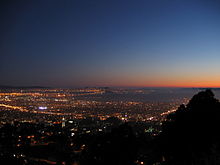
- Berkeley Art Museum and Pacific Film Archive
- Berkeley Free Clinic, a free clinic operating since 1969.
- Berkeley High School
- Berkeley Historical Society and Museum (1931 Center St.)
- Berkeley Marina
- Berkeley Public Library (Shattuck Avenue at Kittredge Street)
- Berkeley Repertory Theatre
- Berkeley Rose Garden
- Cloyne Court Hotel, a member of the Berkeley Student Cooperative
- The Martin Luther King Middle School (Berkeley)
- Berkeley Jazz Festival)
- Indian Rock Park
- Judah L. Magnes Museum
- Lawrence Berkeley National Laboratory
- Lawrence Hall of Science
- Regional Parks Botanic Garden
- Telegraph Avenue and People's Park, both known as centers of the counterculture of the 1960s
- Tilden Regional Park
- University of California, Berkeley
- The Campanile (Sather Tower) in the University of California, Berkeley campus.
- University of California Botanical Garden
- Urban Ore
Parks and recreation

The city has many parks, and promotes greenery and the environment. The city has planted trees for years and is a leader in the nationwide effort to re-tree urban areas.[
Landmarks and historic districts
165 buildings in Berkeley are designated as local landmarks or local structures of merit. Of these, 49 are listed in the National Register of Historic Places, including:
- Berkeley Community Theatre, which is on its campus.[107]
- Berkeley Women's City Club, now Berkeley City Club – Julia Morgan (1929–30)
- First Church of Christ, Scientist – Bernard Maybeck (1910)
- St. John's Presbyterian Church – Julia Morgan (1910), now the Berkeley Playhouse
- Studio Building – architect not recorded, built for Frederick H. Dakin (1905)
- Henry Mather Greene(1908–10)
Historic districts listed in the National Register of Historic Places:
- George C. Edwards Stadium– Located at intersection of Bancroft Way and Fulton Street on University of California, Berkeley campus (80 acres (32 ha), 3 buildings, 4 structures, 3 objects; added 1993).
- Site of the State Asylum for the Deaf, Dumb and Blind, also known as The California Schools for the Deaf and Blind – Bounded by Dwight Way, the city line, Derby Street, and Warring Street (500 acres (2.0 km2), 20 buildings; added 1982). The school was closed in 1980 and the Clark Kerr Campus was opened in 1986.
Arts and culture

Berkeley is home to the
Additionally, Berkeley is home to the off-broadway theater
Annual events
- Jewish Music Festival[111] – March
- Cal Day, University of California, Berkeley Open House[112] – April
- Berkeley Arts Festival[113] – April and May
- Himalayan Fair[114] – May
- The Berkeley Juneteenth Festival – Adeline/Alcatraz Corridor – June
- Berkeley Kite Festival[115] – July
- Berkeley Juggling and Unicycling Festival[116] – July or August
- The Solano Avenue Stroll[117] – Solano Avenue, Berkeley and Albany – September
- The Bay Area Book Festival[118] – Martin Luther King Jr. Civic Center Park and throughout Downtown Berkeley – May
Education
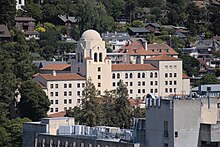
Colleges and universities
The Graduate Theological Union, a consortium of eight independent theological schools, is located a block north of the University of California Berkeley's main campus. The Graduate Theological Union has the largest number of students and faculty of any religious studies doctoral program in the United States.[119] In addition to more theological schools, Zaytuna College, a newly established Muslim liberal arts college, has taken 'Holy Hill' as its new home. The Institute of Buddhist Studies has been located in Berkeley since 1966. Wright Institute, a psychology graduate school, is located in Berkeley. Berkeley City College is a community college in the Peralta Community College District.
Primary and secondary schools

The Berkeley Unified School District operates public schools.
The first public school in Berkeley was the

The East Bay campus of the German International School of Silicon Valley (GISSV) formerly occupied the Hillside Campus, Berkeley, California; it opened there in 2012.[121] In December 2016, the GISSV closed the building, due to unmet seismic retrofit needs.[122]
There is also the Bay Area Technology School, the only school in the whole Bay Area to offer a technology- and science-based curriculum, with connections to leading universities.
Berkeley also houses Zaytuna College, the first accredited Muslim, liberal-arts college in the United States.
Public libraries
Government

Berkeley has a council–manager government.[2] The mayor is elected at-large for a four-year term and is the ceremonial head of the city and the chair of the city council. The Berkeley City Council is composed of the mayor and eight council members elected by district who each serve four-year terms. Districts 2, 3, 5 and 6 hold their elections in years divisible by four while Districts 1, 4, 7 and 8 hold theirs in even-numbered years not divisible by four. The city council appoints a city manager, who is the chief executive of the city. Additionally, the city voters directly elect an independent city auditor, school board, and rent stabilization board. Most city officials, including council members, are elected using instant-runoff voting since November 2010.
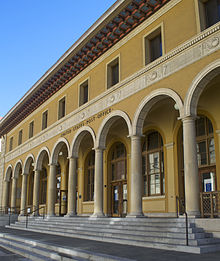
Kriss Worthington, elected in 1996 to represent District 7, became the first openly LGBT man elected to the Berkeley City Council. Lori Droste, elected in 2014 to represent District 8, became the first openly LGBT woman elected to the Berkeley City Council. Terry Taplin, elected in 2020 to represent District 2, became the first openly LGBT person of color elected to the Berkeley City Council.
In 1973, Ying Lee became the first Asian American city councilmember in Berkeley.[123] Jenny Wong, elected in 2018, is the first Asian American City Auditor in Berkeley.
In 2014, the City of Berkeley passed a redistricting measure on the ballot
Nancy Skinner became the first student to serve on the City Council, elected in 1984 as a graduate student. Rigel Robinson, who was elected in 2018, became the second student to serve on the City Council as he completed his master's degree while in office.
The city's Public Health Division is one of four municipally-operated public health agencies in California (the other three being Long Beach, Pasadena, and Vernon). Though it is part of the city government, it qualifies for the same state funds as a county public health department.[126]
Berkeley is also part of
In addition to the Berkeley Unified School District (which is coterminous with the city), Berkeley is also part of the Bay Area Rapid Transit District (BART), the Alameda-Contra Costa Transit District (AC Transit), the East Bay Regional Park District, the East Bay Municipal Utility District, and the Peralta Community College District.[128]
Politics

Berkeley has been a Democratic stronghold in presidential elections since 1960, becoming one of the most Democratic cities in the country. The last Republican presidential candidate to receive at least one-quarter of the vote in Berkeley was Richard Nixon in 1968. Consistent with Berkeley's reputation as a strongly liberal and/or progressive city, in the 2016 presidential election more votes were won by Green Party presidential candidate Jill Stein than by Republican candidate Donald Trump.[129] In the 2020 Presidential election, Joe Biden received 93.8% of the vote while Donald Trump received 4.0% of the vote.[130]

According to the California Secretary of State, as of August 30, 2021, Berkeley has 75,390 registered voters. Of those, 56,740 (75.26%) are registered Democrats, 1,910 (2.53%) are registered Republicans, 14,106 (18.71%) have declined to state a political party affiliation, and 2,634 (3.49%) are registered with a third party.[131]
Berkeley became the first city in the United States to pass a sanctuary resolution on November 8, 1971.[132]
Media

The city had a daily newspaper, the Berkeley Gazette, which was founded c. 1877 and folded in 1984.[133] The Berkeley Barb published counter-culture news from 1965 to 1980. Current media include The Daily Californian, the student newspaper of UC Berkeley, the Berkeley Times, and local online-only publications Berkeleyside, the Berkeley Daily Planet, and The Berkeley Scanner.
Notable people
Notable individuals who were born in and/or have lived in Berkeley include Steve Wozniak, scientists J. Robert Oppenheimer and Ernest Lawrence, actors Ben Affleck and Andy Samberg, Major League Baseball broadcaster Matt Vasgersian, Billie Joe Armstrong, lead singer of Green Day, Adam Duritz of Counting Crows, rapper Lil B, authors Ursula K. Le Guin and Michael Chabon, entertainment and real estate mogul Herbie Herbert, and EDM producer KSHMR, and university presidents Blake R. Van Leer and Darryll Pines.
Sister cities
Berkeley has 17
| Sister City | Year Established |
|---|---|
Sakai, Osaka , Japan
|
1966 |
| Edda people, Imo State, Nigeria | 1982 |
| San Antonio Los Ranchos, El Salvador | 1983 |
Haidian District, Beijing , China
|
1985 |
| Gao, Mali | 1985 |
| Mathopestad, South Africa | 1986 |
| León, Nicaragua | 1986 |
Brits , South Africa
|
1986 |
| Jena, Thuringia, Germany | 1989 |
| Yondó, Colombia | 1990 |
| Dmitrov, Russia | 1991 |
| Uma Bawang, Borneo, Malaysia[135] | 1991 |
| Ulan-Ude, Russia | 1992 (cancelled in 2022 due to the war in the Ukraine) |
Yurok Tribe , California, United States
|
1993 |
Blackfeet Nation, Montana , United States
|
2000 |
| Palma Soriano, Cuba | 2002 |
| Gongju, South Korea | 2018 |
See also
References
- ^ "California Cities by Incorporation Date". California Association of Local Agency Formation Commissions. Archived from the original (Word) on November 3, 2014. Retrieved March 27, 2013.
- ^ a b c "Structure of Berkeley Government". City Clerk. City of Berkeley. Archived from the original on June 23, 2016. Retrieved June 13, 2016.
- ^ a b "Elected Officials Home". City of Berkeley. Retrieved December 8, 2016.
- ^ "Senators". State of California. Retrieved March 18, 2013.
- ^ "Members Assembly". State of California. Retrieved March 18, 2013.
- ^ "California's 12th Congressional District - Representatives & District Map". Civic Impulse, LLC. Retrieved March 9, 2013.
- ^ "2020 U.S. Gazetteer Files". United States Census Bureau. Retrieved October 30, 2021.
- ^ "Berkeley". Geographic Names Information System. United States Geological Survey, United States Department of the Interior. Retrieved February 8, 2015.
- ^ a b "ZIP Code(tm) Lookup". United States Postal Service. Retrieved November 24, 2014.
- ISBN 978-0-520-26667-4. Archived from the originalon March 21, 2012. Retrieved March 23, 2012.
- ^ "Mongoloid Type Skeleton is Dug Up at Berkeley". Oakland Tribune. June 20, 1925. Retrieved December 4, 2022.
- ^ Dinkelspiel, Frances (April 8, 2016). "Ohlone human remains found in trench in West Berkeley". Bekeleyside. Retrieved December 12, 2022.
- ^ "The Spanish Myth". April 3, 2016. Archived from the original on March 4, 2018. Retrieved March 3, 2018.
- ^ National Park Service. "Juan Bautista de Anza". Borrego Springs Chamber of Commerce. Archived from the original on July 25, 2013. Retrieved February 12, 2013.
- ^ Stadtman, Verne, ed. (1967). The Centennial Record of the University of California. Regents of the University of California. p. 114. Archived from the original on June 29, 2014. Retrieved June 23, 2013.
- ^ "George Berkeley – Biography". European Graduate School. Archived from the original on February 25, 2013.
- ISBN 1-884995-14-4.
- ^ Berkeley Gazette. 1900 April 9
- ^ Berkeley 1900: Daily Life at the Turn of the Century, by Richard Schwartz. 2000. page 187
- ^ "Statutes of California, 1877–78, p. 888" (PDF). Archived from the original (PDF) on December 27, 2016.
- ^ Schwartz, Richard. "The Chinese workers who fought discrimination at an 1880s West Berkeley soap factory". BerkeleySide. Retrieved October 13, 2022.
- ^ "Trip to Berkeley, California, Lcmp003 M3a29754". Library of Congress.
- ISBN 9781467545679. An online facsimile of the entire text of Vol. 1 is posted on the Traditional Fine Arts Organization website. Archived April 29, 2016, at the Wayback Machine
- ISBN 978-0-8310-7101-1.
- ^ "Downtown Berkeley Historic Resources Reconnaissance Survey" (PDF). City of Berkeley. August 2007. Archived from the original (PDF) on May 24, 2017. Retrieved January 14, 2017.
- ^ Exactly Opposite the Golden Gate, edited by Phil McCardle, published 1983 by the Berkeley Historical Society, p.251
- ^ "Statutes of California, 1907-9, p.1208" (PDF). Archived from the original (PDF) on December 4, 2019. Retrieved November 28, 2019.
- San Jose Mercury News.
Single-family zoning, a form of exclusionary zoning, traces its roots in the U.S. to Berkeley in 1916, when city leaders sought to segregate white homeowners from apartment complexes rented by minority residents. It's become the default policy in cities and suburbs across the country.
- San Jose Mercury News.
Berkeley is thought to be the birthplace of single-family residential zoning; it began in the Elmwood neighborhood in 1916, where it forbade the construction of anything other than one home per lot. That has historically made it difficult for people of color or those with lower incomes to purchase or lease property in sought-after neighborhoods, city officials said. ... Even after racial discrimination such as redlining — refusing home loans to those in low-income neighborhoods — was outlawed, it continued in the form of single-family zoning, he said.
- ^ Baldassari, Erin; Solomon, Molly (October 5, 2020). "The Racist History of Single-Family Home Zoning". NPR. Archived from the original on November 14, 2020.
Where Did Single-Family Zoning Get Its Start? In none other than true-blue Berkeley, California. The progressive Bay Area enclave was the first city in the country to implement single-family zoning. It adopted the zoning rule for the Elmwood neighborhood in 1916, making it illegal to build anything other than one home on one lot in the neighborhood.
- ^ Metcalfe, John (February 17, 2021). "Berkeley may get rid of single-family zoning as a way to correct the arc of its ugly housing history". Berkeleyside.
- ^ "Berkeley, A City in History" Archived January 2, 2014, at the Wayback Machine. Berkeley Public Library.
- ^ "California – Race and Hispanic Origin for Selected Cities and Other Places: Earliest Census to 1990". U.S. Census Bureau. Archived from the original on August 12, 2012.
- ^ "Shattuck Avenue: Commercial Corridor Historic Context and Survey". City of Berkeley. Retrieved October 5, 2017.
- ^ Savidge, Nico (July 25, 2023). "Berkeley is adding new housing at the fastest rate in decades". Berkeleyside.
- .
- ^ City of Berkeley. "Urban Design and Preservation Element". Archived from the original on April 18, 2017. Retrieved April 17, 2017.
- ^ "Ordinance: Rent Stabilization and Eviction for Good Cause - City of Berkeley, CA". Cityofberkeley.info. Archived from the original on September 29, 2019. Retrieved September 29, 2019.
- ^ "What is Rent Control? ... and How Does It Affect Me?". City of Berkeley. Archived from the original on April 18, 2017. Retrieved April 17, 2017.
- ^ "Our History". Ecology Center. Archived from the original on April 18, 2017. Retrieved April 17, 2017.
- ^ Mark A. Stein (November 3, 1986). "Progressives in Berkeley Challenged by Tradition". L.A. Times. Retrieved April 17, 2017.
- ^ Joe Garofoli (December 12, 2012). "Ethel Manheimer, Berkeley activist, dies". SFGate. Retrieved January 1, 2013.
- ^ "Berkeley, CA Home Prices & Housing Information". AreaVibes. Archived from the original on December 29, 2014. Retrieved December 30, 2014.
- ^ Chloee Weiner (June 8, 2015). "South Berkeley residents mobilize around plan to develop Adeline Street corridor". Daily Cal. Archived from the original on May 24, 2017. Retrieved April 17, 2017.
- ^ "School Colors". Frontline. Archived from the original on July 3, 2015. Retrieved July 2, 2015.
- ^ "International Student Enrollment Data". UC Berkeley. Retrieved April 17, 2017.
- ^ Richard Brenneman (April 6, 2007). "Panoramic Sells Off 7 Apartment Buildings". Berkeley Daily Planet. Archived from the original on April 18, 2017. Retrieved April 17, 2017.
- ^ "Berkeley becomes first US city to declare Bisexual Pride Day, support 'marginalized' group". The Washington Post. Retrieved September 19, 2012.[dead link]
- ^ Lovett, Ian (September 3, 2014). "Berkeley Pushes a Boundary on Medical Marijuana". The New York Times. Archived from the original on January 1, 2022. Retrieved January 21, 2015.
- ^ "How Did Berkeley Pass A Soda Tax? Bloomberg's Cash Didn't Hurt". NPR. Archived from the original on May 9, 2015.
- ^ Emilie Raguso (June 11, 2015). "Police report mistakes, challenges in Berkeley protests". Berkeleyside. Archived from the original on April 26, 2017. Retrieved April 17, 2017.
- ^ Emilie Raguso (June 11, 2015). "BPD chief: Lessons learned in 2014 'Black Lives Matter' protests guided us during Milo demonstrations". Berkeleyside. Retrieved April 17, 2017.
- ^ James Queally; Paige St John; Benjamin Oreskes; David Zahniser (August 28, 2017). "Violence by far-left protesters in Berkeley sparks alarm". Los Angeles Times. Retrieved April 15, 2018.
- ^ "Heavy Police Presence Keeps Berkeley Coulter Protests Peaceful". April 27, 2017. Archived from the original on August 10, 2019. Retrieved March 4, 2019.
- ^ "People's Park protesters arrested by UC Berkeley police before removal of trees". The Mercury News. January 15, 2019. Retrieved March 4, 2019.
- ^ .
- ^ .
- ^ a b c Simon, Harry (March 1992). "Towns without Pity: A Constitutional and Historical Analysis of Official Efforts to Drive Homeless Persons from American Cities". Tulane Law Review. 66: 47. Archived from the original on October 26, 2019. Retrieved July 3, 2020 – via HeinOnline.
- S2CID 144592825.
- ISBN 9781134001866.
- ^ "1950s '60s Counterculture, Feb 9 2017 | Video | C-SPAN.org". C-SPAN.org. Retrieved April 27, 2018.
- ^ CiteSeerX 10.1.1.498.2766. Archived(PDF) from the original on October 9, 2022.
- ^ S2CID 143224475.
- ProQuest 222074477.
- ^ "Mission & History". April 4, 2014. Archived from the original on December 7, 2017. Retrieved December 7, 2017.
- ^ JSTOR 29768172.
- ^ a b c d Williams-Ridley, Dee (July 25, 2017). "2017 Berkeley Homeless Point-In-Time Count and Survey Data". Archived from the original on June 25, 2018. Retrieved April 28, 2018.
- ^ "A Report on the 2015 Alameda County Point In Time Count" (PDF). Alameda County Public Health Department. Archived (PDF) from the original on October 9, 2022.
- PMID 24826829.
- ^ Williams-Ridley, Dee (July 25, 2017). "2017 Berkeley Homeless Point-In-Time Count and Survey Data". Archived from the original on June 25, 2018. Retrieved April 28, 2018.
- ^ "Records Online - City of Berkeley, CA". Cityofberkeley.info. Archived from the original on May 11, 2018. Retrieved May 10, 2018.
- ^ a b c d e "Records Online - City of Berkeley, CA". Cityofberkeley.info. Archived from the original on April 29, 2020. Retrieved May 22, 2020.
- ^ "Arreguín, Jesse. "Update on Berkeley Homeless Task Force Recommendations." Received by Members of the City Council, City of Berkeley, 23 Jan. 2018". Archived from the original on January 9, 2019. Retrieved January 9, 2019.
- ^ Fabisch, M.P. (June 6, 1990). "Revised Date for Split of 415 (California) Numbering Plan Area" (PDF). BellCore Letter. Archived from the original (PDF) on June 4, 2011. Retrieved June 1, 2011.
- ^ "2008 Bay Area Earthquake Probabilities". USGS. Archived from the original on June 29, 2015. Retrieved June 26, 2015.
- ^ "U.S. Geological Survey Liquefaction Hazard Maps". U.S. Geological Survey. USGS. Archived from the original on February 19, 2015. Retrieved February 18, 2015.
- ^ "Earthquake in San Francisco and Neighboring Places" (PDF). The New York Times. October 22, 1868. Archived from the original (PDF) on January 16, 2020. Retrieved June 13, 2018.
- ^ Lawson, A. C. (ed.), The California Earthquake of April 18, 1906, 1908, Reprinted 1969 by the Carnegie Institution of Washington. This is a comprehensive report on the 1906 earthquake, published by the State Earthquake Investigation Commission, and comprises two volumes and an atlas. It contains a discussion of the 1868 Hayward Fault earthquake and its effects, and includes a number of photos taken by Lawson himself of damage in Berkeley caused by the 1906 quake. The report is available from the USGS. "1906 Earthquake – References". Earthquake.usgs.gov.
- ^ Rademacher, Horst. "The California Memorial Stadium". Haywardfaultucberkeley.pressbooks.com.
- ^ Rademacher, Horst (June 6, 2017). The Hayward Fault at the Campus of the University of California, Berkeley: A Guide to a Brief Walking Tour (PDF). Berkeley Seismological Laboratory. pp. 17–21. Archived (PDF) from the original on October 9, 2022.
- ^ "Jane Houston Jones. San Francisco Weather – Weird and Wacky. SJAA Ephemeris July 2001". Ephemeris.sjaa.net. July 19, 2007. Retrieved November 12, 2013.
- ^ "Climatography of the United States : No. 20 : 1971-2000" (PDF). Cdo.ncdc.noaa.gov. Archived from the original (PDF) on July 25, 2013. Retrieved January 21, 2015.
- ^ Western Regional Climate Center Web site
- ^ "NOWData – NOAA Online Weather Data". National Oceanic and Atmospheric Administration. Retrieved June 17, 2022.
- ^ "Summary of Monthly Normals 1991–2020". National Oceanic and Atmospheric Administration. Retrieved January 4, 2023.
- ^ "Quick Facts with 2020 Decennial Census data". Census.gov. Retrieved August 12, 2020.
- ^ "P004: Hispanic or Latino, and Not Hispanic or Latino by Race – 2000: DEC Summary File 1 – Berkeley city, California". United States Census Bureau. Retrieved January 26, 2024.
- ^ "P2: Hispanic or Latino, and Not Hispanic or Latino by Race – 2010: DEC Redistricting Data (PL 94-171) - Berkeley city, California". United States Census Bureau. Retrieved January 26, 2024.
- ^ "P2: Hispanic or Latino, and Not Hispanic or Latino by Race – 2020: DEC Redistricting Data (PL 94-171) - Berkeley city, California". United States Census Bureau. Retrieved January 26, 2024.
- ^ "2020 Quick Facts Search: CA - Berkeley city". U.S. Census Bureau. Retrieved August 12, 2020.
- ^ "2010 Census Interactive Population Search: CA - Berkeley city". U.S. Census Bureau. Archived from the original on October 11, 2014. Retrieved July 12, 2014.
- ^ "2007–2011 American Community Survey 5-Year Estimates". Factfinder2.census.gov. Archived from the original on February 12, 2020.
- ^ "Berkeley CA crime rates and statistics - NeighborhoodScout". neighborhoodscout.com. Retrieved August 25, 2015.
- ^ "Crime in Berkeley, California (CA): murders, rapes, robberies, assaults, burglaries, thefts, auto thefts, arson, law enforcement employees, police officers, crime map". city-data.com. Retrieved August 25, 2015.
- ^ Bicycle and Pedestrian Safety in Berkeley Archived April 23, 2010, at the Wayback Machine, City of Berkeley.
- ^ Savidge, Nico (May 16, 2023). "Berkeley's top transportation official is out of his job". Berkeleyside.
- ^ "Chicanery tops meters in Berkeley", San Francisco Chronicle.
- ^ Berkeley Gazette, January 22, 1903
- ISBN 978-0-916374-27-3.
- ISBN 978-0-916374-66-2.
- ^ "California Highways and Public Works, March-April 1963, pp.61-64" (PDF).
- ^ "Annual Comprehensive Financial Report for the Year Ended June 30, 2021" (PDF). City of Berkeley. p. 352. Archived from the original (PDF) on January 7, 2022. Retrieved January 1, 2022.
- ^ "Economic Development and Employment Element". General Plan. City of Berkeley. Archived from the original on April 19, 2017. Retrieved April 19, 2017.
- ^ Massara, G. Haley (June 18, 2014). "Berkeley City Council moves to limit abundance of large drugstores". Daily Californian. Archived from the original on April 19, 2017. Retrieved April 19, 2017.
- ^ "Solano Avenue Stroll | Street Festival & Parade Berkeley Albany | Solano Avenue Association". Solanoavenueassn.org. Archived from the original on May 7, 2020. Retrieved May 22, 2020.
- ^ "Berkeley Path Wanderers Association". Berkeleypaths.org. Retrieved January 21, 2015.
- ^ "Berkeley High". Berkeleyheritage.com. Retrieved November 12, 2013.
- ^ "Addison St – Freight and Salvage Aug09". City of Berkeley, CA. Archived from the original on December 9, 2012. Retrieved July 15, 2013.
- ^ "About Berkeley Rep: Who we are". Berkeley Repertory Theatre. Archived from the original on July 17, 2017. Retrieved July 26, 2017.
- ^ "Mission, Core Values, and History". BAMPFA. February 23, 2015. Archived from the original on December 17, 2023.
- ^ "Jewish Music Festival". jewishmusicfestival.org. Archived from the original on January 25, 2014. Retrieved January 27, 2014.
- ^ "Cal Day 2013 | Share". UC Berkeley. Archived from the original on December 8, 2015. Retrieved January 27, 2014.
- ^ "berkeleyartsfestival.com". berkeleyartsfestival.com. Archived from the original on February 14, 2014. Retrieved January 27, 2014.
- ^ "himalayanfair.net". himalayanfair.net. Archived from the original on January 20, 2014. Retrieved January 27, 2014.
- ^ "Berkeley Kite Festival website". Highlinekites.com. July 28, 2013. Retrieved November 12, 2013.
- ^ "2011 Berkeley Juggling & Unicycle Festival". Berkeleyjuggling.org. Retrieved January 27, 2014.
- ^ "Solano Avenue Stroll website". Solanoavenueassn.org. November 6, 2007. Retrieved November 12, 2013.
- ^ "Home". Bay Area Book Festival.
- S2CID 60574333.
- ^ Berkeley Daily Planet, January 22–24, 2008
- ^ Taylor, Tracey (November 13, 2012). "German School opens on historic Berkeley campus". Berkeleyside. Retrieved March 21, 2017.
- ^ Taylor, Tracey (December 7, 2016). "Future uncertain for Berkeley school due to unsafe building". Berkeleyside. Retrieved February 16, 2017.
- ^ Kelley, Sara Rounsaville and Max (November 3, 2022). "Remembering Ying Lee, WWII refugee who became Berkeley's first Asian American councilmember". Berkeleyside. Retrieved February 6, 2024.
- ^ "Berkeley City Council's historic offer: Take a seat, Cal". August 22, 2013. Archived from the original on December 17, 2018. Retrieved December 17, 2018.
- ^ Orenstein, Natalie (December 7, 2018). "All the Berkeley election results: Finalized counts confirm month-long leads". Berkeleyside. Retrieved February 6, 2024.
- ^ Kassabian, Sara (April 15, 2020). "Berkeley is unusual in having its own public health division. How does that work during a pandemic?". Berkeleyside. Archived from the original on April 29, 2020. Retrieved May 9, 2020.
- ^ California Government Code § 23004
- ^ Alameda County. "District Lookup Search". Acgov.org. Archived from the original on February 9, 2019. Retrieved February 9, 2019.
- ^ "How Berkeley Voted: Clinton 90.4%; Trump 3.2%. Category: Page One from The Berkeley Daily Planet". Berkeleydailyplanet.com. Archived from the original on October 26, 2019. Retrieved October 14, 2019.
- ^ "November 3, 2020, General Election : Supplement to the Statement of Vote" (PDF). Elections.cdn.sos.ca.gov. Archived (PDF) from the original on October 9, 2022. Retrieved February 21, 2022.
- ^ "Report of Registration as of August 30, 2021 : Registration by Political Subdivision by County" (PDF). Elections.cdn.sos.ca.gov. Archived (PDF) from the original on October 9, 2022. Retrieved February 21, 2022.
- ^ "Berkeley Is The Original Sanctuary City" Archived September 4, 2019, at the Wayback Machine East Bay Express, February 14, 2017.
- UPI. March 11, 1984. Retrieved November 29, 2020.
- ^ "City of Berkeley Sister Cities". City of Berkeley. Archived from the original on May 5, 2017. Retrieved October 16, 2019.
- ^ "Berkeley's Borneo Project Aims to Restore Lands by Teaching Mapping By MATTHEW ARTZ". The Berkeley Daily Planet. Archived from the original on February 22, 2014. Retrieved February 7, 2014.
Further reading
- Exactly Opposite the Golden Gate, edited by Phil McCardle. Berkeley Historical Society, 1983
- Berkeley: The Life and Spirit of a Remarkable Town, Ellen Weis, photographs by Kiran Singh. Berkeley: Frog, Ltd. 2004 ISBN 1-58394-093-6
- Berkeley Inside/Out, Don Pitcher, history sections by ISBN 0-930588-33-9
- A Heartbreaking Work of Staggering Genius, by Dave Eggers.
External links
- Official website
- . Encyclopædia Britannica (11th ed.). 1911.
- Berkeley Daily Gazette, Google news archive. —PDFs of 8,057 issues, dating from 1911 to 1946.
- Finding Aid to City of Berkeley Records, The Bancroft Library
- U.S. Geological Survey Geographic Names Information System: Berkeley, California




